Cornering and Descending.
The same thing?
Pretty much. There isn’t much to descending in a straight line – just relax. Cornering and descending are both about controlling the bike under its own momentum. The significant difference between cornering on a descent and cornering on the flat is that the bike tends to speed up during a downhill corner whereas on a flat, or uphill corner it tends to slow down.
Lean and Line
Cornering technique can be broken down into two distinct aspects.
- Lean is just you and the bike – you can practise lean on an empty sheet of tarmac.
- Line is the route that you follow on the road.
Lean comes first
Why?
In order to corner fast and safely you have to be relaxed and conscious of what you are doing with your body and your bike. Get this right and the line is easy. The right line without the right lean will be safe, sort of, but either slow or precarious.
Lean
Knee in or knee out?
In general I’d say in – especially on fast corners. As you are approaching the corner the act of sitting upright and sticking out your knees and elbows will help you slow down. Once into the corner it’s better to squeeze the bike with the thighs.
Drops or hoods?
It doesn’t matter. Ultimately you will have better control at speed on the drops. If you are not comfortable on your drops it's probably because your set up is wrong. Holding onto the tops is not a good idea – even on long straight descents - because changing your hand position to reach the brakes can make you unstable at exactly the moment you want to be in complete control!
The basics
You should have your weight on the outside leg and the inside arm . This will result in the outside pedal being down which in turn will result in the inside pedal being up and well clear of the ground. You should do your braking before starting to turn. You should keep your head and eyes level. You should lean the bike (rather than turning the handlebars). You should look where you are going – i.e where you want to go.
Refinement
More than just leaning on the inside arm think about pushing on that end of the handlebars – under-steering or counter-steering.
Rather than just pushing down with the outside leg think about forcing your heel down behind the pedal.
Remember that you want to keep your bike between you and the road and you want to keep the grippy rubber bits pressed down into the tarmac.
Think about leaning the bike rather than your body. If there is one thing that will give you confidence in your ability to corner fast this is it.
The French way and the Italian way
I once read that the French cornered by leaning their bikes and keeping their bodies upright while the Italians cornered by leaning their bodies and keeping their bikes upright. I’ve certainly seen plenty of good cyclists corner using the ‘Italian’ technique but my experience, and all the good stuff that I’ve read, places me firmly on the side of the French! Sacré Bleu!
Practising Lean
Every corner is an opportunity to practise though there are few opportunities on the open road to practise to the limit. Quiet car parks and school playgrounds are ideal. There you can create your own corners and circuits and practise at leisure.
Line
The Racing Line
The racing line is the shallowest curve. Watching motorcycling on the TV will give you a pretty good idea of the racing line. There is a significant difference between motorcycling and pedal cycling of course: Motorcyclists can apply power when the bike is leaning over (i.e. right through the corner) – cyclists have to wait until the bike is almost upright. The main difference between cornering on descents and cornering on the flat is that the bike speeds up through the corner on a descent but slows down on the flat.
The ideal racing line uses the whole road. Racers on closed circuits or closed roads have several advantages over cyclists on the open road:
- there is no other traffic
- visibility is normally good – there are no blind bends
- they get plenty of opportunity to practise on the circuit so they know what’s coming even if they cannot see it.
On the open road there might be traffic and even if you know what the road ahead is like you cannot guarantee that it is clear. In most cases the racing line is not the safe line.
The Safe Line
The safe line is the one that allows you to corner as quickly as is safely possible. This means that you take advantage of the width of the road that you can see but don’t assume that it is clear where you can’t. You also mustn’t assume that you know where the road is going to go until you can see it.
The safe line typically means approaching the corner wide, i.e. towards the left hand side of the road if the corner is to the right, and turning towards the apex when you can see where the apex is.
The most common error is to turn in too soon, i.e. before you see the corner opening out. There are several possible outcomes:
- if you were going slowly enough you might still be able to take the corner safely
- you will be thrown outwards which might result in you going off the road or might result in you heading towards oncoming traffic
- you brake and lose speed
- you lose control and crash
- you bring someone else down
The picture below shows the racing line and a safe line through a set of hairpin bends. The important thing to note is that the safe line will depend far more on the conditions. It might be safe for the red line to cross the centre line where visibility is good and the road is clear - indeed it might be safer between points 1 and 2 as it would reduce the likelihood of drifting onto the wrong side of the road at point 3.
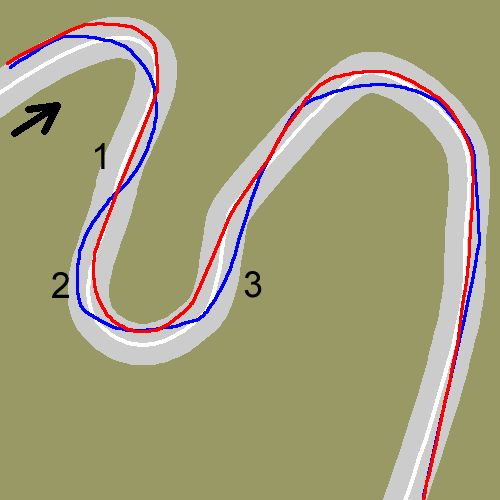
This picture illustrates what happens if you turn in too soon...
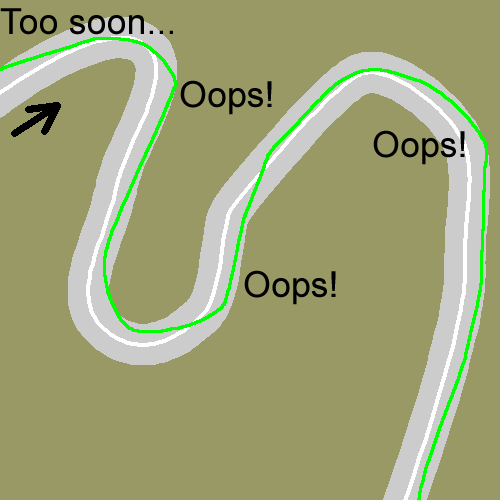
Dangers
There is a certain inherent danger when cornering even when the lean and line are perfect. You are completely reliant on the friction between your tyres and the ground. There are several things frequently encountered on the road that can change that friction: water, gravel, paint (i.e. road markings), ironworks (drain covers etc), ice, mud, leaves and diesel to name the most common constituent parts. There are also a few things on your bike that can change the friction: most obviously the tyres but also the brakes, rims, spokes, wheel bearings and headset bearings.
Most of these dangers can be alleviated or removed completely simply by ensuring that your bike is well maintained, that you pay attention to what you ride it over and that you pay attention to the road and weather conditions.
Here are some photos of masters in action...
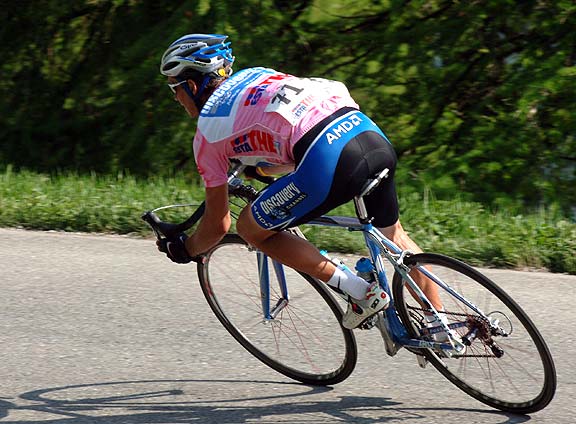
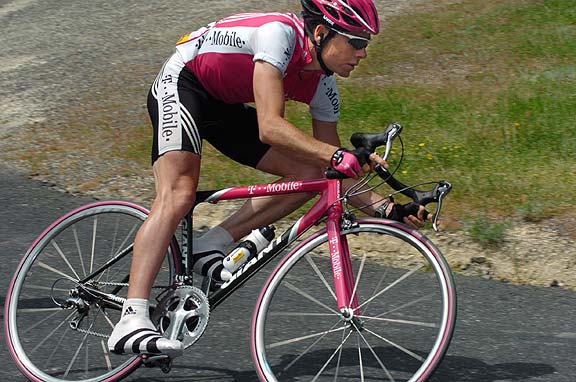
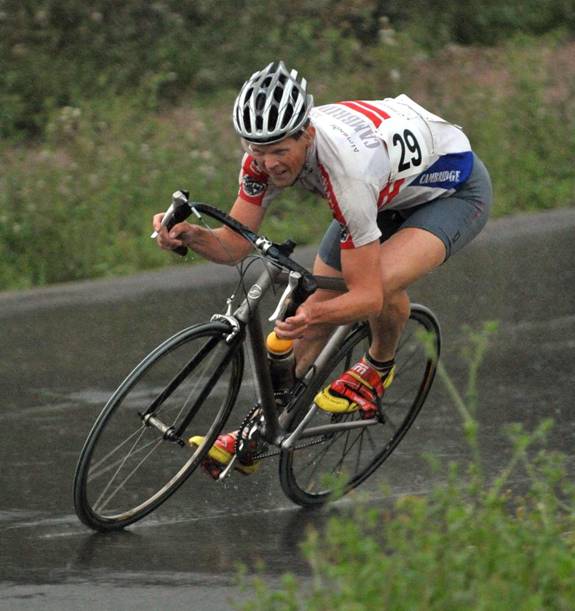
Don't just copy the pros, however, some of them really don't do it well at all
Tim Williams - October 2003
